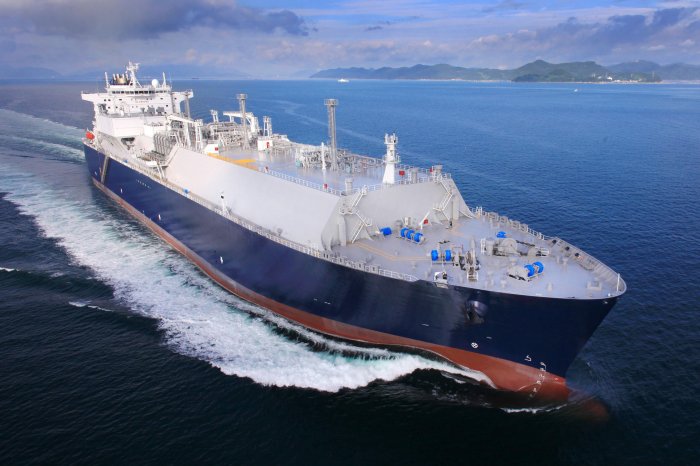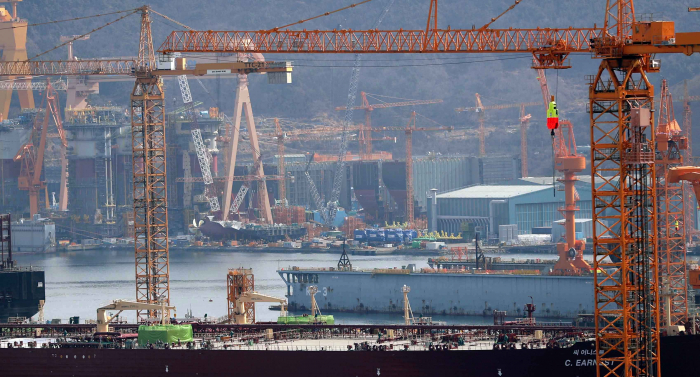Samsung Heavy set for 2023 turnaround after eight years of losses
The shipbuilder is confident of turning to the black next year on a string of profitable orders
By Apr 11, 2022 (Gmt+09:00)
LG Chem to sell water filter business to Glenwood PE for $692 million


Kyobo Life poised to buy Japan’s SBI Group-owned savings bank


KT&G eyes overseas M&A after rejecting activist fund's offer


StockX in merger talks with Naver’s online reseller Kream


Mirae Asset to be named Korea Post’s core real estate fund operator



Samsung Heavy Industries Co., one of South Korea's Big Three shipbuilders, was once on the list of assets its parent Samsung Group wanted to sell to Hanwha Group in a package deal back in 2014.
But the shipbuilder was excluded from the so-called big deal worth 2 trillion won ($1.6 billion) between Samsung and Hanwha in 2015 for unknown reasons.
Since 2015 Samsung Heavy has been accumulating operating losses, which are estimated to balloon to 5.8 trillion won ($4.7 billion) by the end of this year.
"Market talk has been spreading that Samsung Group executives regretted failing to sell Samsung Heavy at the time," a shipbuilding industry official told The Korea Economic Daily.
But the shipbuilding arm is gearing up for a turnaround. The company expects to swing to an operating profit in 2023 on the back of a series of profitable orders it has won in recent years.
This year Samsung is forecast to report its eighth consecutive year of shortfalls with an operating loss of 210.2 billion won, according to financial data provider FnGuide on April 10.
But the estimated figure is down sharply from its operating loss of 1.3 trillion won the year previous.
Samsung's reliance on floating production storage and offloading facilities has taken a heavy toll on the company. Global oil giants canceled their orders for the floating vessels or delayed their delivery dates. The manufacturing and relevant costs of the undelivered ships were booked as losses.
Next year Samsung Heavy is expected to turn to an estimated operating profit of 186.1 billion won, according to FnGuide.
"A stack of low-priced orders we had bagged before and heavy fixed costs will make it difficult to turn to the black this year," said a Samsung Heavy official.
"But from 2023, we will make a sharp rebound in sales and swing to a profit, along with improved financial structure."
To enhance its financial health, Samsung Heavy raised a combined 3.7 trillion won in three rounds of rights issues between 2016 and 2021.
Samsung Electronics Co., its largest shareholder with a 15.23% stake, participated in all of its rights offerings, along with other Samsung Group affiliates and individual shareholders.

TURNAROUND
Buoyed by expectations of post-pandemic economic recovery and growing trading volume, Samsung Heavy won a total of $12.2 billion in new orders to build 80 vessels in 2021, exceeding its annual target by 34%.
Late last year it got rid of another headache, selling a drillship it had in stock and securing around 300 billion won in new cash.
Thanks to the robust orders and rising vessel prices, Samsung has already secured two years of workloads through the first half of 2024.
Since the start of this year, it has added four liquefied natural gas (LNG) carriers and nine container ships to its order book, achieving about a quarter of its target of $8.8 billion in orders for this year.
The new orders will begin to be reflected in its balance sheet from next year as it takes about one and a half years to build and deliver a ship.
Samsung and its domestic peers are also set to benefit from tougher regulations on maritime emissions taking effect from next year. To meet the stricter emission standards, shipping companies are expected to place new orders for eco-friendly vessels and ship modification.
Shares in Samsung Heavy closed 1.83% higher at 5,550 won on Monday, bouncing back from its record-low 2,899 touched in 2019. But its share price is still about one-sixth of its peak of 33,111 won reached in 2013.
Write to Ik-hwan Kim at lovepen@hankyung.com
Yeonhee Kim edited this article.
-
 Shipping & ShipbuildingKorea shipbuilders to win mega tanker deals on rising LNG demand
Shipping & ShipbuildingKorea shipbuilders to win mega tanker deals on rising LNG demandMar 30, 2022 (Gmt+09:00)
3 Min read -
 War in UkraineKorean shipbuilders see material impact from sanctions on Russia
War in UkraineKorean shipbuilders see material impact from sanctions on RussiaMar 13, 2022 (Gmt+09:00)
3 Min read -
 Shipping & ShipbuildingBig 3 Korean shipbuilders win largest orders in 8 yrs
Shipping & ShipbuildingBig 3 Korean shipbuilders win largest orders in 8 yrsDec 31, 2021 (Gmt+09:00)
2 Min read


